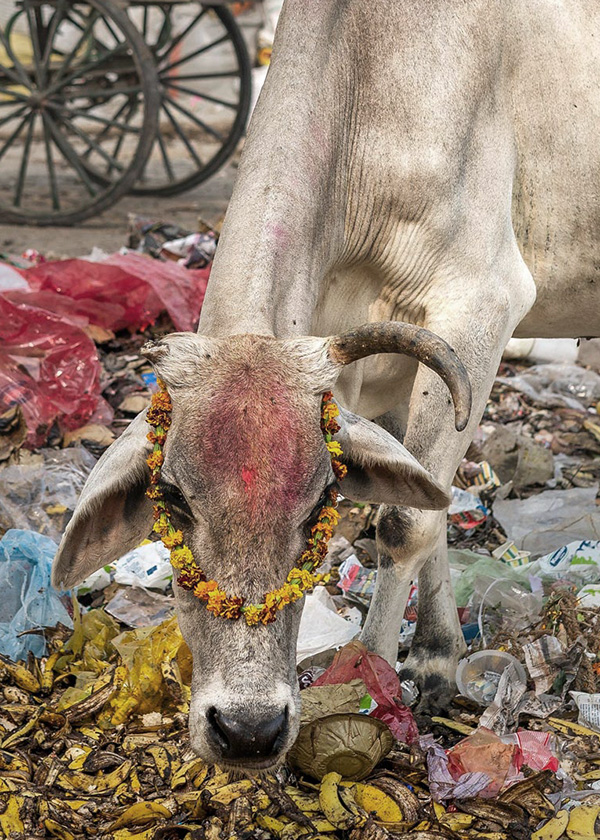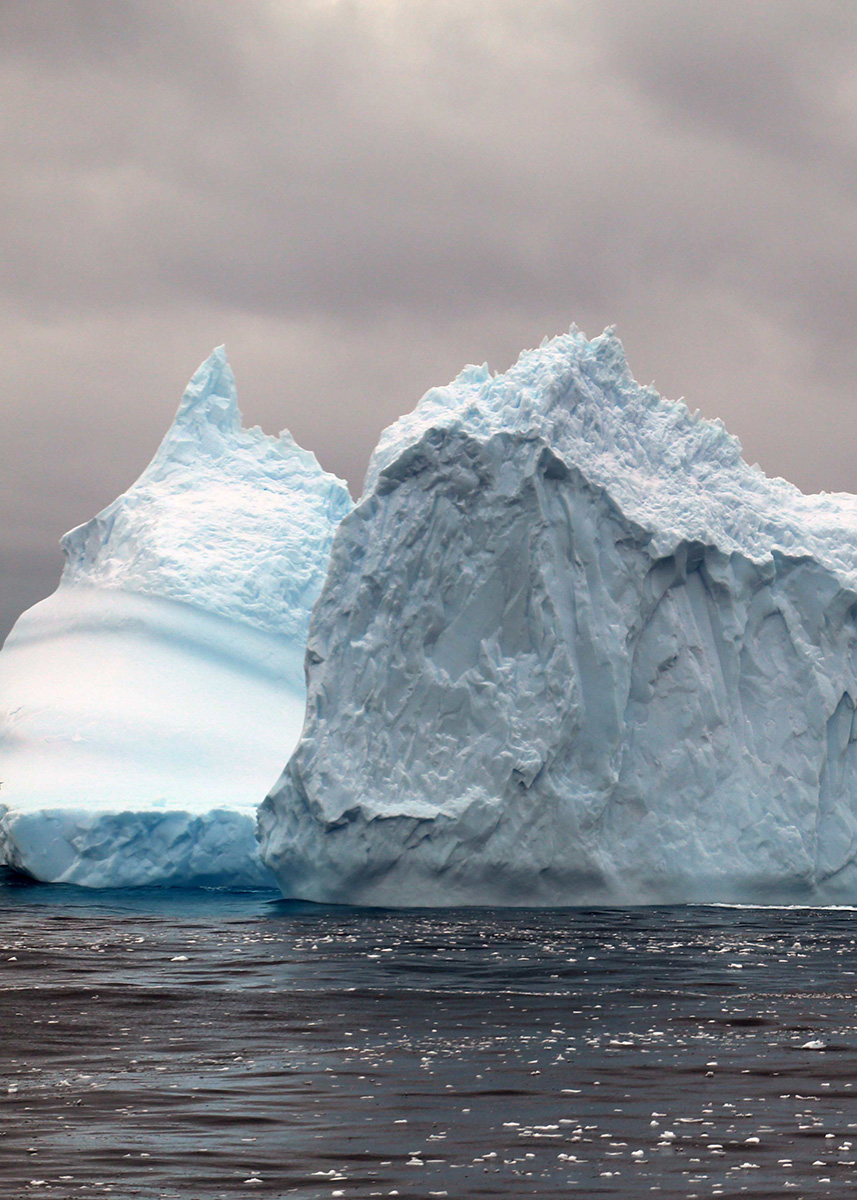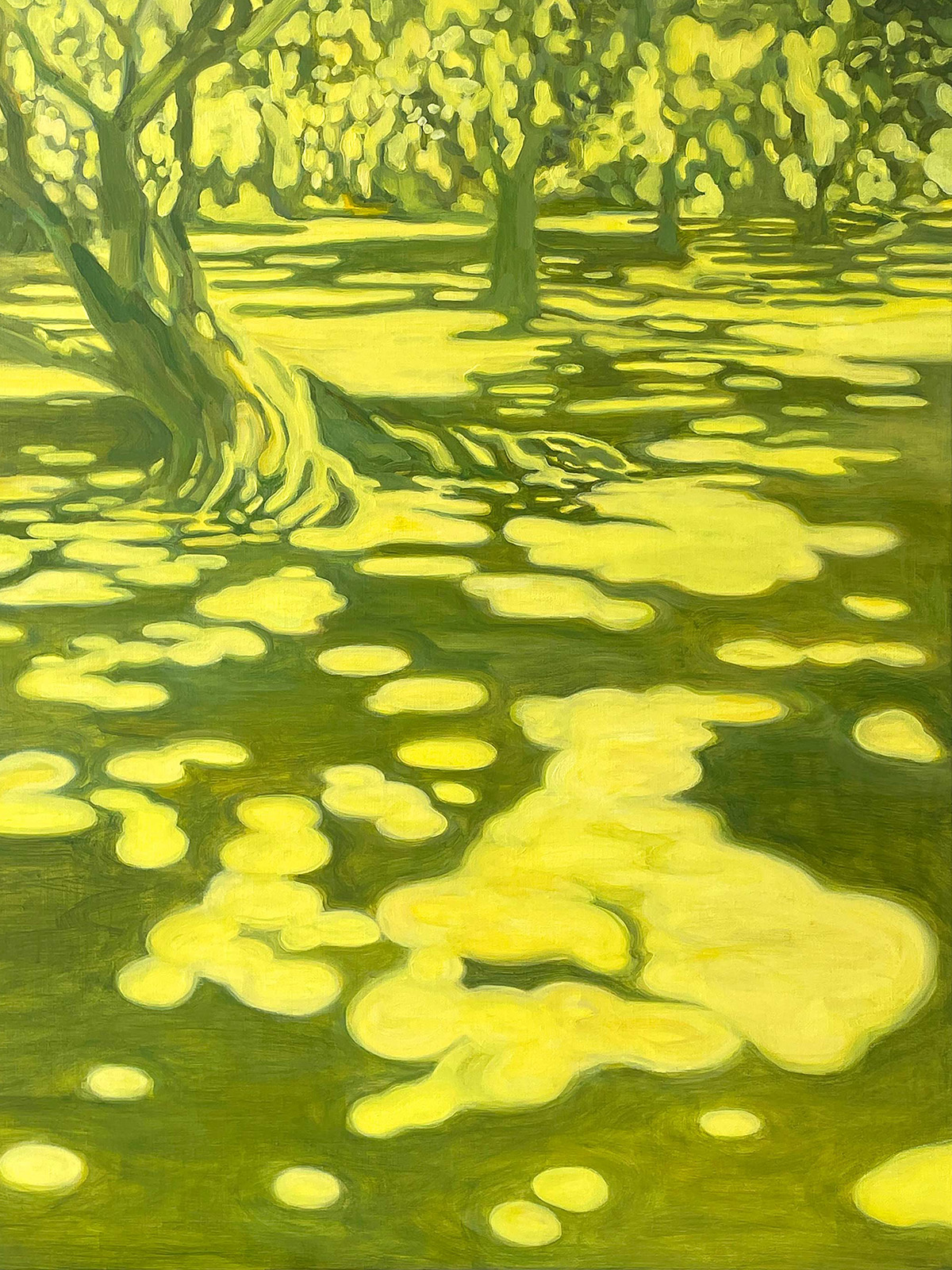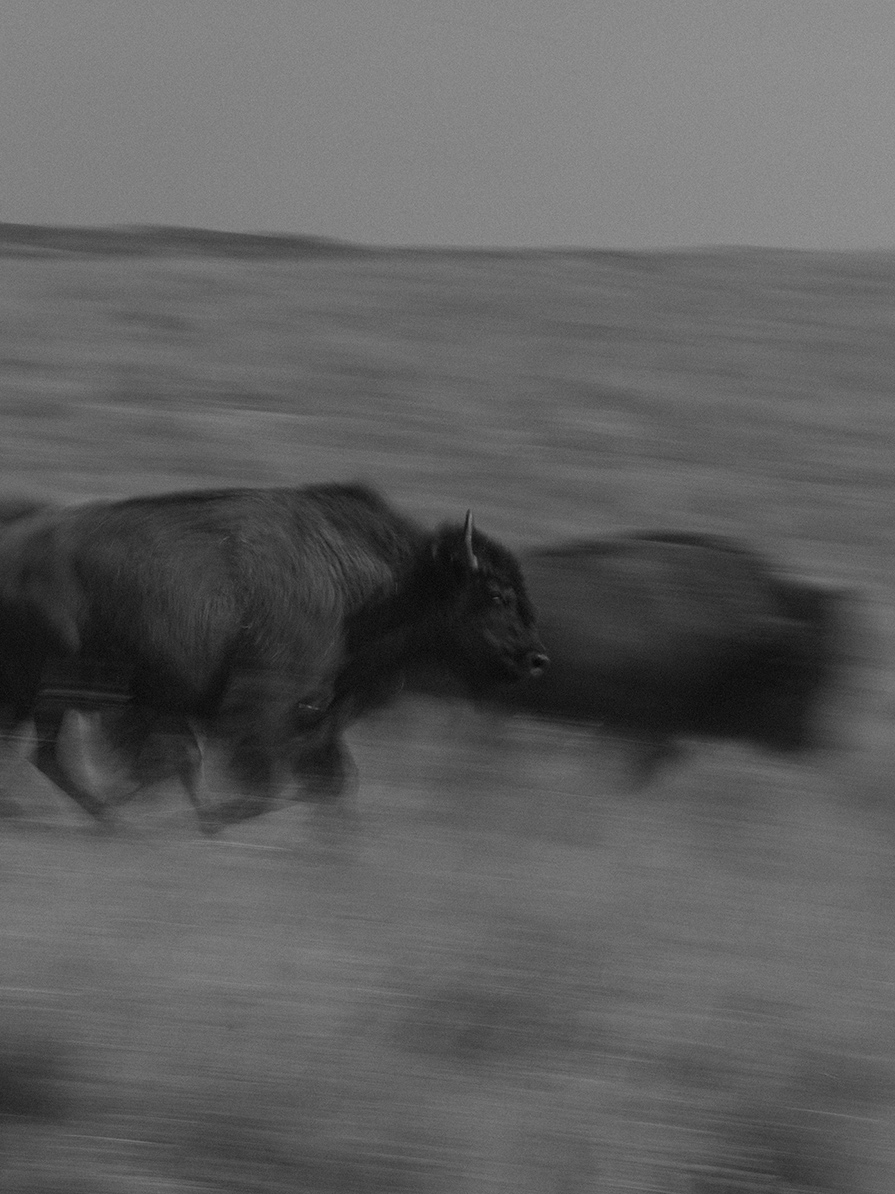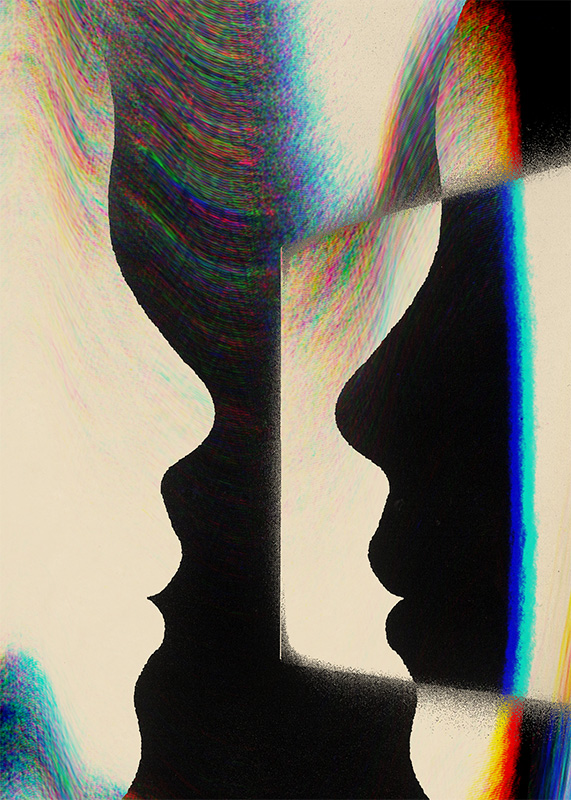


Illustration by Lucille Clerc
Invasives
Unknitting Despair in a Tangled Landscape
by Catherine Bush
Catherine Bush is the author of five novels, including Blaze Island, a Globe and Mail Best Book; and The Rules of Engagement, a New York Times Notable Book and a Globe and Mail and L.A. Times Best Book of the Year. She has been shortlisted for the Trillium and City of Toronto Book Awards and was recently a Fiction Meets Science Fellow at the HWK in Germany. Her work has been published in The New York Times, Brick, and Best Canadian Essays. She is an associate professor at the University of Guelph, where she coordinates the Creative Writing MFA program. She lives and writes in Toronto and eastern Ontario.
Lucille Clerc is a French graphic designer and illustrator based in London. Her work includes editorial design and illustration for books and magazines. Her clients include Penguin, Granta, Elephant Magazine, and DC Comics. In the past five years, she has studied green spaces in London and Paris, inspired by the relationship between Nature and urbanization. She creates large-scale compositions and architectural portraits of her favorite places, exploring their past and present lives.
In a time of mounting ecological loss, Catherine Bush tends to the understory. As invasive plants proliferate in a park near her childhood home in Toronto, she considers her family’s own history as transplanted immigrants and how acts of reciprocity and care for the land might unknit despair.
In the four-hundred-acre park a few blocks from my home, I uproot plants: small rosettes of serrated, palm-shaped leaves; slim stalks of jagged-edged green topped with florets of tiny white flowers. It’s mid-morning. I’ve brought garbage bags. I make no attempt to be clandestine. I’m not foraging, like the old Polish-Canadian ladies who come to pluck fresh nettle leaves in the spring, or the older man whom I spot cutting orange chicken-of-the-woods mushroom from a decomposing log. Of course you’re not supposed to harvest here. I abandon my stuffed bag by the garbage bins. In clearing the ground around a couple of aged black oak trees in Toronto’s High Park, I’ve stopped perhaps a few hundred thousand seeds of garlic mustard from forming, an infinitesimal drop in the bucket of the invasive plant growth that is spreading through the ravine understory. Futile, likely, but I’m searching to kick-start a response beyond the complicated grief I feel at the sight.
Everywhere humans have traveled, we’ve brought alien species, intentionally and unintentionally. Arriving in a new place, the populations of some such species explode, cause land trauma, displace and eliminate native species, chemically altering the soil to make it inhospitable to other plants. Garlic mustard confronts me in a place where I’ve walked daily for years. I try helplessly to remember when the understory didn’t look like this. Once I stumbled across the plant growing benignly along a woodland trail in northwest Germany and was shocked at its innocuous presence, nothing like its monocultural massing in my local habitat. Yet our relationship has an intimacy, one I share with the other invasive species I encounter on my daily park walks. Thick stands of Himalayan balsam push out the native wild impatiens on the riparian flats beside degraded, still spring-fed Spring Creek; dog-strangling vine twists around saplings in the more open savannah understory.
My parents arrived in Toronto at the end of the 1950s amid the vast, postwar boom of immigration. Both had histories tying them to the city. In the mid-1930s, my paternal grandparents gave up their brief immigrant life in Toronto running a fish-and-chip shop and sailed back to the UK with their Toronto-born, two-year-old son, only to meet the onslaughts of war a few years later. Fearing a Nazi invasion, my maternal grandparents sent my six-year-old mother from their English home to Canada; after five years in Toronto with a foster family, she returned to Norwich an eleven-year-old stranger. History nevertheless entangles us in the waves of Anglo-European invasion that have swept across the continents, including the six centuries of genocidal colonialism in North America.
How can I, child of immigrants, with a long cultural history of colonial extirpation behind me, object to the presence of other invasives, I wonder, as I walk the park’s wooded landscape. Aren’t humans apex invasives, triumphant at eliminating other species and creating monocultures? What I’m trying to figure out is how, in these days of mounting ecological loss, I can love and care for land that isn’t mine, land that I’ve inhabited for years yet where I have no personal ancestry, land historically stolen from its Indigenous inhabitants, which has nevertheless become my microclimate.
I grew up in Toronto on the borders of ravines, my earliest years spent in an apartment tower not far from the massive Don Valley, through which a highway and the Don River, the city’s major east-side water artery, cut winding parallel paths towards Lake Ontario. A few years later we moved to a new, suburban townhouse complex that backed onto an open ravine through which ran Deerlick Creek, a tiny Don River tributary. We were among the earliest waves of immigrants to live there, whiter than those who came after us. Almost all of us had floated in from elsewhere, my parents from England, others from Germany, Scotland, the Netherlands, Indonesia—postwar seedpods drifting onto unfamiliar soil.
How can I, child of immigrants, with a long cultural history of colonial extirpation behind me, object to the presence of other invasives?
As a child I did not know the name of the creek. It was the late 1960s. We walked to school unaccompanied through ravine or woods. Unsupervised, we tobogganed down tree-filled slopes and raced through the woodland playing games. Eager arrivals, my parents taught us to identify local flora and fauna: trout lily, milkweed, darting chickadees, the red flare of a cardinal. Meanwhile, there were deeper layers of a human palimpsest that we knew nothing of. Twenty years after we’d moved to a house on another ravine, artifacts would be dug from this one: thousand-year-old pottery shards; a two-thousand-year-old knife; a human face carved in a pebble, dated to 4,700 BC, making it one of the oldest human representations found in northeastern North America.
As a child, I felt beset by elsewhereness. I did not know how to feel at home in a place where, though I learned the names of plants, I walked only on the surface of the ground, sensing human histories unknown to me, longing for deeper rootedness. Attaching myself to local settler stories felt like playacting, culturally ours yet somehow appropriated. England, with its treeless mountains and small robins—nothing like the red-breasted thrush I saw—was far-off, not mine either. As I stumbled into adulthood, I wondered whether to keep moving or figure out how to be where I was. For more than a decade, I left Toronto for New England. Returned. Left Toronto. Returned again.
The west-end part of the city where I’ve lived for the past sixteen years was once a tended wilderness of black oak savannah, lanky trunks rising above a mixed, grassy understory. Some kilometers to the west, the major waterway of the Humber River empties into Lake Ontario, now spilling beneath the cement ramps of a highway. These High Park acres are the remains of a 4,000-year-old ecosystem, once sustained by Indigenous inhabitants, who engaged in carefully managed burns, which, instead of harming the oaks, promoted their regeneration and allowed a complexity of plants to flourish.
In the grassy groves where I walk, the bent arms of remnant oak trees corkscrew to the sky. Saplings, nurtured through new burns prescribed by park management, rise among the long-trunked elders. This is a fragile, vestigial habitat, a relic of a vastness that once was. Behind the small yard of my Toronto home, Indian Road bears north from the lake, its southernmost blocks following the route of a pre-existing Indigenous trail that connected to major trade routes through this landscape, routes used for thousands of years. A plethora of local street names contain this contentious word—Indian Grove, Indian Trail, Indian Road Crescent among them—signaling presences now largely driven from these locales, even as a new surge of voices urges the replacement of these street names. Let Indian Road become Mikana Anishinaabe.
Europeans brought garlic mustard to North America in the early 1800s as an edible herb. All parts of this nutritious, medicinal plant, high in Vitamin A and C, can be eaten. Squeeze the leaves and you release the telltale garlic scent. I’ve sautéed the spring leaves, blended them into pesto. The park could harvest and monetize its rampant growth, I think as I search for the few remaining clumps of trillium, which unfurl with suddenness in the spring woods, their tricorned petals a brilliant blaze.
More understory: In 1873, English-born John Howard, forward-thinking in his way—Toronto’s first architect and one of the first residents to have a flush toilet—donated a large tract of land at Toronto’s western borders to the city with the stipulation that it become a park and be left in a largely natural state. He had acquired the land in order to create a sheep farm and built a charming residence on a rise overlooking the lake to the south; but he never farmed. At first, the city, which had not yet expanded this far west, did not know what to do with the bequest and considered refusing it.
Capitalist theorists speak of the tragedy of the commons as a rationale for private property ownership: individuals with access to a public space will overuse it, driven by self-interest, rather than collectively tending it for mutual good. In a capitalist society, we outsource a park’s management, entering its landscape in the expectation that it will fulfill our immediate, individual needs. We’re not schooled to enter a park as if plunging into a space-time continuum, alive to its long, multispecies history and possible future, asking, How can I take care of this place while it takes care of me?
In later spring, on the low hillsides that I pass as I enter the off-leash dog trails, the stalks of dog-strangling vine spiral upward, seeking open patches of the understory, twisting around the slimmest trunks, eventually enfolding saplings in massed foliage, their tiny flowers forming clusters of beady red eyes. Brought from eastern Europe and southwestern Russia, the vine, officially pale swallowwort and a member of the milkweed family, can produce up to several thousand seeds per square meter in its slim, bean-shaped pods, self-sowing avidly, the vines strangling other plants and taking over habitats, surely capable of enwrapping small mammals as well. Nor is it easily eradicated; dog-strangling vine grows not only from seed but also from root fragments, often left behind when you attempt to uproot it. It’s the one invasive plant for which the park consistently applies a pesticide.
One year, I joined the volunteer park stewards in their organized garlic mustard removal and stuffed bag after bag with plants, only these efforts never targeted the parts of the park where I walked. I struggled to unsee the invasives, blur all plant life into an undifferentiated zone of green, yet seemed neurologically incapable of not-noticing. Forest-bathing became a fraught practice. And didn’t Shinrin-yoku, for all its meditative beauty rooted in gratitude, focus on human responsiveness rather than what the forest might want or not want from our presence?
It’s not as if I believed there was somewhere I could run to escape plant invasives—a prelapsarian wild. Surely, though, there were landscapes in which it was possible to gain relief from their oppressive ubiquity. Capitalism dangled a lure: if I owned some land of my own, I could take action that offered solace while effecting change, if on a microscale. I had a job, an income that I could leverage to borrow money, though not a lot of it. Two and a half hours east of the city, I found a small place on a dirt road that appears, across fields, as an island of poplar, pine, sugar maple, Manitoba maple, elm. Why not buy myself a bit of salvation?
Acquiring a tiny acreage on the traditional lands of the Anishinabeg Nation—with a schoolhouse built by three English settlers in the 1860s, according to the marble slab above the front door, from stones left to litter the ground by retreating glaciers ten thousand years ago—was hardly running away from histories of invasion; it was more like walking in through another door.
The road on which the schoolhouse stands bears the family name of two of these men. They must have hewn the long cedar logs that form the building’s foundation, wood likely taken from the nearby cedar grove that still encircles my neighbor’s spring-fed pond. Within the thick-walled schoolhouse—lived in since the 1960s, when all one-room schoolhouses in the province were decommissioned—two large slate blackboards still occupy opposite walls. Wide windows and high ceilings make the interior feel airy, porous to the outdoor world. Up a small slope lies what must have once been a playing field. Aging, non-native Scots pines stand like craggy masts at the property’s perimeter, planted by schoolchildren in the 1940s, around the time my shy, uprooted mother was arriving in Toronto to escape the brutalities of European war.
We’re not schooled to enter a park as if plunging into a space-time continuum, alive to its long, multispecies history and possible future.
Behind the schoolhouse, in the middle of a sloped lawn dotted with poplar and a couple of spiny hawthorns, rises a small stone obelisk, visible from the back door. No gravestones remain: their bases form the obelisk’s foundation, this being the sole monument to an abandoned local cemetery used from 1800 until 1910, according to the obelisk’s carved plaque. I, who don’t know where my own grandparents are buried, am uncertain who or how many were interred here. This isn’t my history, but it is the legacy of white people’s settlement in this corner of the world. No one seems to know who owns the cemetery. Enclosed within my fence line, it’s mine to care for. Some might find it strange to have the long-ago dead as neighbors. Yet to walk about with this history right beneath my feet, to be responsible for mowing the grass above, keeps this past pertinently present.
And it was here, during my first summer in the country, that I encountered a new plant invasive.
A local acquaintance pointed out a tall plant with an assertive stalk culminating in a pancake of yellow florets. Did I know what it was? Familiar with many plant species, I didn’t recognize this one: wild parsnip, a relative of both giant hogweed and Queen Anne’s lace, brought to North America by Europeans who grew it for its edible root. He gave me a warning: Its hollow stems contain a sap that, on contact with skin, causes phytophotodermatitis, a chemical reaction that makes skin extremely sensitive to UV light. That is to say, the sap can burn you, leave you unable to go out into daylight for years, even blind you if the sap gets into your eyes. Most of the men in my rural neighborhood bear scars from encounters with it. Once I looked around, I realized that wild parsnip was everywhere.
It grew in the lawn and along the borders of my acreage. Plants teemed through the uncut field to the west, the one to the north, the verges of the hay field to the east. Along the roadsides, stalks with branches of large, saw-toothed leaves stood at attention, offering up a citrine haze of flowers. I watched a video of someone in a white hazmat suit taking out stalks by hand. Cover yourself well when removing it. Wear goggles. Uproot the small first-year plants, cut the taller second-year growth at the base of the stem. Don’t burn the plants. The smoke can be toxic. Wild parsnip can be found across North America, but in the last decade environmental conditions in eastern Ontario have led to its exponential spread. In my township, workers have begun to spray verges to control it, poisoning the bloomy stands of lilac as well.
Non-native plant species are all around us, including those long woven into the fabric of our landscape: the medallions of edible dandelions that stud lawns and provide first food to bees are a Eurasian native; lilacs, intoxicating the early summer air with their perfume, originated in Asia, arriving on this continent via Europe a couple of centuries ago. But habitat-destroying invasives seem to be altering landscapes ever more fundamentally. Now the common reed, European phragmites, is on the move: its feathery fronds rise to five-meter heights, while 80 percent of its biomass expands in rhizome networks below ground. The plants plug up wetlands, banish the candles of native cattails, and displace nesting wildlife. On my fortnightly drives between city and country, I’d swear there are more massing in the ditches all the time. A large stand plumes at the end of the concession road south of the schoolhouse, larger each year; fronds have infiltrated a marshy expanse on the concession road to the north. How vulnerable my neighbor’s cattail-laced pond feels.
Yet on my small plot, I can turn grief and dismay into another kind of care. First of all, I suit up, in knee-high boots, safety glasses, long sleeves. With long-handled loppers, I cut down all the wild parsnip that I find on my property. I tackle the throng on the borders of the field to the east, hoping to keep the plant from seeding itself in the neighbor’s hay.
The cull is a reminder of how much killing goes on when gardening, if one accepts the encounter with plants as engagement with another kind of being. Part of me wants to turn the proliferating wild parsnip into an enemy, a malignancy to be eradicated. But this means ignoring our metaphoric likenesses, our inextricable connectedness, which is hardly anthropomorphism. To recognize the plant’s invasiveness truthfully, I need to acknowledge past and ongoing human invasiveness, our own species’ cancerous propensity for unfettered growth.
What I desire, I tell myself, is not control but the agency to engage in acts of repair. This becomes my schooling. With a landscape gardener, I make a plan for new native meadows and pay her to take up large swaths of grass on the playing field. Later, another bed will become a woodland garden. I’m using money I should be saving for when I grow old. Still, insisting on the need for other kinds of survival feels a necessary if fragile gift to a larger world. Is what I’m doing a form of rewilding? Regeneration feels closer to the mark. The land can’t go back to what it once was any more than I can return to the land of my ancestors and find myself at home. Nor is it certain that any of this will outlast my life in this place. I have no idea who will come after me. Under capitalism, whoever owns this land can mow down my plantings and resort to a monocultural desert of non-native lawn if they wish. Even in the short term, who knows what the new summer droughts and unpredictabilities of shifting weather patterns will bring.
Deep-rooted native grasses—big bluestem, little bluestem, a switchgrass called Prairie Fire—clump in rippling spires in the new beds. In the spring, tiny sweat bees, small carpenter bees, fat bumblebees emerge to sizzle among the blossoms of the still-petite American plum, so many that the whole tree seems to vibrate. One midsummer day, a hummingbird moth feeding on the steeples of bee balm startles me. By later summer, the stacking, crown-like flowers of self-sowing spotted bee balm draw pollinators in droves. I leave the grass on the low slope leading down to the schoolhouse uncut so that it sings with grasshoppers and crickets. I stand beside it, eyes closed, listening until my body hums. Nothing like this may have grown here before, but these plants will, with luck, nourish soil in all its microbial complexity as well as sustain other native life forms.
Care isn’t just sentiment; the labor of embodied actions becomes a way to unknit despair. There is toil in labor, also collaboration and elation. I kneel to work the earth between my fingers, uprooting proliferating plants to make space for others. I leave the first of the season’s dandelions for the bees but remove seedlings from the garden beds; tackle the pervasive root systems of creeping bellflower; uproot and eat a stand of garlic mustard. I plant burr oak and sugar maple saplings, trees that have historically grown in this place, hoping that these youngsters will survive the hotter, dryer summers and the increasing invasions of gypsy moth caterpillars. What weather will they encounter if they’re still here in fifty years? One hundred?
Care isn’t just sentiment; the labor of embodied actions becomes a way to unknit despair.
As summer progresses, I hike the woodlot trail on my neighbor’s large acreage carrying a pocketknife. Having been given permission to walk on this land, I return the favor with habitat care. There are occasional patches of dog-strangling vine, not large enough yet to be destructive. By cutting back stems and removing seed pods before they open, I can at least slow the vine’s spread. I try to cultivate a simultaneous mental practice: historically dubious ownership can’t be my sole motivation for care. I let my awareness extend outward, to the Tyendinaga Mohawk reserve to the southeast, on the north shore of Lake Ontario; to the Alderville First Nation some fifty miles inland and to the west, where the closest residential school, the Alnwick Industrial School, opened in 1838 and did not close until 1966, a haunting parallel timeline to that of the schoolhouse which I now inhabit. Self-interest doesn’t vanish entirely. The illusion of control offers an elusive comfort against a larger climate of grief. Yet as I walk, I enter a spatial and temporal web in which it’s hubris to feel that I’m the only being with agency in this matrix of life forms, even if the agency of other beings doesn’t look like mine.
Years ago, just after the release of my second novel, I was lucky enough to assist the esteemed writer and naturalist Barry Lopez in a workshop at the Bread Loaf Writers’ Conference. One day, Lopez asked students to describe, tenderly, the landscape they’d passed through on the way to class—without using the word. The prompt became a lesson in how tenderness invites us to notice the vivid details that bring the world to life. Both tenderness and attention share a root in the Latin verb tendere, meaning to stretch, extend, as we do when reaching toward another, acknowledging possible reciprocity rather than grasping for an inanimate object.
In coming to the schoolhouse, I longed to learn a place by returning to it. I grew to hold the knowledge that re-seeing brings as a counterweight to the current dangers: the burning sap in the wild parsnip stalks; the sudden, intense windstorms accompanying weather front shifts, like the one that knocked down two weedy Manitoba maples, prairie natives, in a matter of minutes; the Lyme disease–bearing ticks, which are also endemic, migrating north as the climate warms—all this now being what wildness encompasses. Both the dog and I have been treated for the presence of Lyme: an engorged tick attached to my back proved to be Lyme-positive; the dog carries Lyme pathogens in her blood. Yet, when I lay a hand to the ground, what I feel isn’t terror but a surge of love.
Out here, the landscape undulates. Mounds of glacial till, left behind at the end of the last ice age as the Wisconsin Glacier retreated northward, rise and fall. Drumlins offer vistas, as if one were standing on the crest of a wave of an inland sea. This topography also marks time, ten thousand years or so of stable Holocene climate.
In the city, the retreating glacier left a larger, deeper lake than present-day Lake Ontario. Scratch the thin, dark layer of topsoil in High Park and you quickly encounter tawny sand from that lake’s bottom, used in the early twentieth century to mortar the foundations of nearby houses, including mine. The pandemic has brought more people than ever into the park: the new wave of humans breaks new trails through the woods, widens old ones, tramples pine duff and leaf mulch, erodes the hillsides, exposing ancient sand. The span of the Holocene crumbles in the basement of my house and beneath our trampling feet. New apartment towers rise on the park’s northern borders, amplifying our ever-rising tide.
One day I make a stab at calculating all the kilometers I’ve walked in the park over the past sixteen years and come up with close to 20,000, a distance farther than that between Toronto and Perth, Australia, the farthest city on Earth from my home. I try to conceptualize this extraordinary distance, the imaginary journey that would take me, step by step, across oceans. I have walked this far in one place, watching the land around me alter through time. Owls still nest in the park, hawks hunt, coyotes build their dens beneath the pines. In spring, a few patches of trillium still wave like clusters of small, white handkerchiefs. There’s talk of returning the black oak savannah to Indigenous stewardship. A birder friend says it will take the park a post-pandemic generation to recover. An herbalist notes that the chemicals that garlic mustard emits in the soil peak and decline in a 25- to 30-year cycle. I don’t see recovery, though, only more change, as I set off once more on a human-widened path, wondering what it means to feel at home. To live with humility and land love amid uncertainty, I hazard. I stop to lay a hand to the scarred, papery skin of a birch, and again to the ribbed bark of a black oak, listening for the invitation to tenderness, our beckoning guide to whatever lies ahead.

